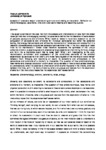Analysis of noise as a way of understanding emotion and making an installation: Reflection on phenomenological, parametric, inner and outer worlds meeting and becoming audible
| dc.contributor.author | Lopreiato, P | |
| dc.date.accessioned | 2021-11-09T17:22:50Z | |
| dc.date.available | 2021-11-09T17:22:50Z | |
| dc.date.issued | 2015-12-01 | |
| dc.identifier.issn | 1477-965X | |
| dc.identifier.issn | 1758-9533 | |
| dc.identifier.uri | http://hdl.handle.net/10026.1/18286 | |
| dc.description.abstract |
<jats:title>Abstract</jats:title> <jats:p>This article is centred on the idea that from the analysis and interpretation of data from the crowd noise (at historical and engaging events) it is possible to define the manifestation of extroversion of people’s perceptions and emotions. What I seek to reveal in my artistic research is not the conjugation of perceptions and emotions for individual participants but rather the collective feeling, the energy that connects and refines the involvement of individuals and creates from it a new and indivisible whole: a collective perception and sentiment that in the multilayering of noise finds its full manifestation. Crowd noise, therefore, represents the synthesis of this unique collective emotion, a psychological and physical synergic experience channelling its force, energy and form into a distinctive event that is noise itself. What I am investigating is the sum, neutralization, enrichment and suppression of the constitutive elements of the emotion experienced by participants in an event, and noise ‘as a register of the intensity of relationships’ between them. Showing and describing an event, its sensations and atmosphere, or the perceptions and emotions of a moment, is impossible. The questions, how emotions emerge, how mental and physical perceptions are stimulated by our senses or how consciousness develops, are unanswerable; what is possible to show as an artist is what happens in the middle, what lies between the lines, within the fabric of events, and what one grasps and realizes from the exploration of what is in the involuntary traces the experience itself leaves behind.</jats:p> | |
| dc.format.extent | 269-274 | |
| dc.language | en | |
| dc.language.iso | en | |
| dc.publisher | Intellect | |
| dc.rights | Attribution-NonCommercial-ShareAlike 4.0 International | |
| dc.rights | Attribution-NonCommercial-ShareAlike 4.0 International | |
| dc.rights.uri | http://creativecommons.org/licenses/by-nc-sa/4.0/ | |
| dc.rights.uri | http://creativecommons.org/licenses/by-nc-sa/4.0/ | |
| dc.title | Analysis of noise as a way of understanding emotion and making an installation: Reflection on phenomenological, parametric, inner and outer worlds meeting and becoming audible | |
| dc.type | journal-article | |
| dc.type | Journal Article | |
| plymouth.issue | 3 | |
| plymouth.volume | 13 | |
| plymouth.publication-status | Published | |
| plymouth.journal | Technoetic Arts | |
| dc.identifier.doi | 10.1386/tear.13.3.269_1 | |
| plymouth.organisational-group | /Plymouth | |
| plymouth.organisational-group | /Plymouth/Faculty of Arts, Humanities and Business | |
| plymouth.organisational-group | /Plymouth/Faculty of Arts, Humanities and Business/School of Art, Design and Architecture | |
| dc.identifier.eissn | 1758-9533 | |
| dc.rights.embargoperiod | Not known | |
| rioxxterms.versionofrecord | 10.1386/tear.13.3.269_1 | |
| rioxxterms.licenseref.uri | http://creativecommons.org/licenses/by-nc-sa/4.0/ | |
| rioxxterms.type | Journal Article/Review |



